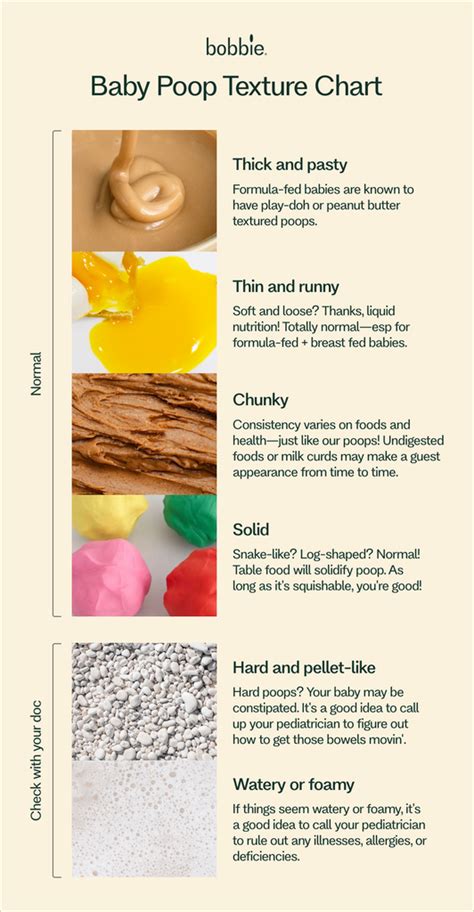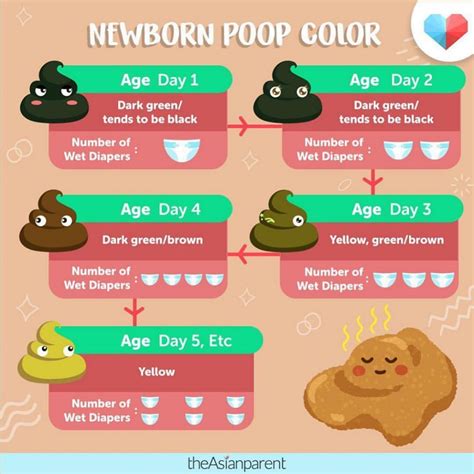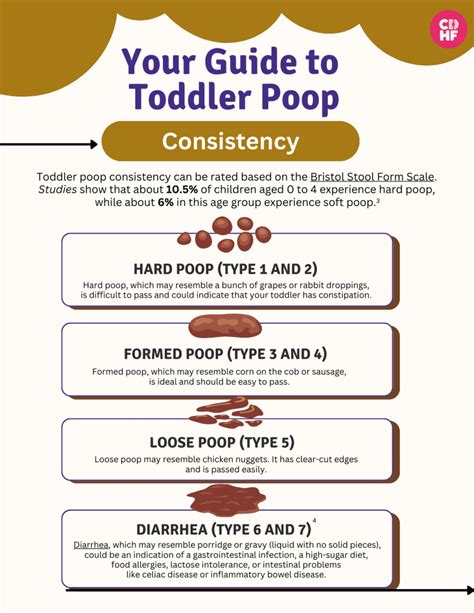Intro
Discover the newborn poop stages guide, covering meconium, transitional, and breastfed baby poop, to understand normal stool colors, consistency, and frequency, ensuring healthy infant development and addressing concerns like constipation and diarrhea.
As a new parent, it's natural to have questions and concerns about your baby's health and development. One aspect that can be particularly puzzling is the various stages of newborn poop. Understanding these stages can provide valuable insights into your baby's digestive health and overall well-being. In this comprehensive guide, we'll delve into the different stages of newborn poop, exploring what's normal, what's not, and when to seek medical attention.
The first few weeks of a newborn's life are a time of significant adjustment, not just for the baby, but for the parents as well. As your baby grows and develops, their poop will undergo several changes, reflecting their digestive system's maturation and adaptation to new foods. Monitoring these changes can help you identify potential issues early on, ensuring your baby receives the best possible care.
Newborns have a unique digestive system that's still learning to process different substances. Their poop can be a useful indicator of their overall health, providing clues about their diet, hydration levels, and potential allergies or sensitivities. By familiarizing yourself with the various stages of newborn poop, you'll be better equipped to recognize when something is amiss and take prompt action to address any concerns.
Newborn Poop Color and Texture Guide

The color and texture of newborn poop can vary significantly, depending on the baby's age, diet, and overall health. In the first few days, newborn poop is typically black and tar-like, a substance called meconium. As the baby begins to feed, either breast milk or formula, their poop will start to change, transitioning through various colors and textures. Understanding these changes is essential for recognizing normal development and potential issues.
Meconium: The First Poop
Meconium is the first poop of a newborn baby, typically passed within the first 24 hours of life. It's black, sticky, and tar-like, composed of waste materials ingested during fetal development. Meconium is a sign that the baby's digestive system is functioning, and it's usually passed in small amounts over the first few days.Transitional Stool: A Mix of Meconium and Milk
As the baby starts feeding, either breast milk or formula, their poop will begin to transition from meconium to a more normal, milky stool. This transitional phase can last several days, during which the poop may appear greenish-black or brown. It's essential to monitor the baby's stool during this period, as any signs of blood or mucus may indicate an issue.Stages of Newborn Poop Development

The development of newborn poop can be broken down into several stages, each reflecting the baby's growth and adaptation to new foods. Understanding these stages can help parents recognize normal development and potential issues.
- Stage 1: Meconium (0-3 days): The first poop of a newborn baby, typically black and tar-like.
- Stage 2: Transitional Stool (4-7 days): A mix of meconium and milk, appearing greenish-black or brown.
- Stage 3: Breast Milk Stool (7-14 days): Soft, yellow, and seedy, with a sweet, sour smell.
- Stage 4: Formula Stool (7-14 days): Firmer, brown, and more formed, with a stronger odor.
Breast Milk Stool: Characteristics and Concerns
Breast milk stool is typically soft, yellow, and seedy, with a sweet, sour smell. It's normal for breastfed babies to have frequent, loose stools, especially in the first few weeks. However, if the stool is consistently watery or contains blood or mucus, it may indicate an issue, such as an allergy or infection.Common Newborn Poop Issues

While most newborn poop issues are minor and temporary, some can be a sign of a more serious problem. It's essential to monitor your baby's stool and seek medical attention if you notice any of the following:
- Blood in the stool: Can be a sign of an infection, allergy, or intestinal issue.
- Mucus in the stool: May indicate an infection or allergy.
- Watery stool: Can be a sign of a viral or bacterial infection.
- Constipation: Can be a sign of a dietary issue or underlying medical condition.
When to Seek Medical Attention
If you're concerned about your baby's stool or notice any of the following, seek medical attention:- Vomiting or diarrhea: Can lead to dehydration and electrolyte imbalances.
- Blood or mucus in the stool: May indicate an infection or underlying medical condition.
- Fever or lethargy: Can be a sign of a serious infection or illness.
- Refusal to feed: May indicate an underlying medical condition or issue with the digestive system.
Newborn Poop and Diet: What's the Connection?

The connection between newborn poop and diet is complex and multifaceted. Breast milk and formula can affect the color, texture, and frequency of stool, while introducing solid foods can lead to changes in the digestive system. Understanding these connections can help parents make informed decisions about their baby's diet and recognize potential issues.
- Breast milk: Typically produces soft, yellow, and seedy stool.
- Formula: Can produce firmer, brown, and more formed stool.
- Solid foods: Can introduce new substances and allergens, potentially affecting the digestive system.
Introducing Solid Foods: Tips and Precautions
When introducing solid foods, it's essential to monitor your baby's stool and overall health. Start with single-ingredient foods and gradually introduce new substances, watching for signs of allergy or intolerance.Conclusion and Next Steps

Understanding the various stages of newborn poop can provide valuable insights into your baby's digestive health and overall well-being. By monitoring your baby's stool and recognizing potential issues, you can take prompt action to address concerns and ensure your baby receives the best possible care. Remember, every baby is unique, and what's normal for one may not be normal for another.
What is the normal color of newborn poop?
+The normal color of newborn poop can vary, but it's typically black (meconium) in the first few days, transitioning to a greenish-black or brown color as the baby starts feeding.
How often should a newborn poop?
+Newborns can poop frequently, especially in the first few weeks. Breastfed babies may poop after every feeding, while formula-fed babies may poop less often.
What are the signs of a newborn poop issue?
+Signs of a newborn poop issue can include blood or mucus in the stool, watery stool, constipation, or refusal to feed. If you're concerned about your baby's stool, seek medical attention.
Now that you've read this comprehensive guide to newborn poop stages, we encourage you to share your thoughts and experiences in the comments below. Have you noticed any unusual changes in your baby's stool? What steps have you taken to address concerns? By sharing your stories and insights, you can help other parents navigate the complex world of newborn poop and ensure their babies receive the best possible care. Don't forget to share this article with friends and family who may be expecting or have recently welcomed a new baby. Together, we can support each other and create a community of informed and empowered parents.
